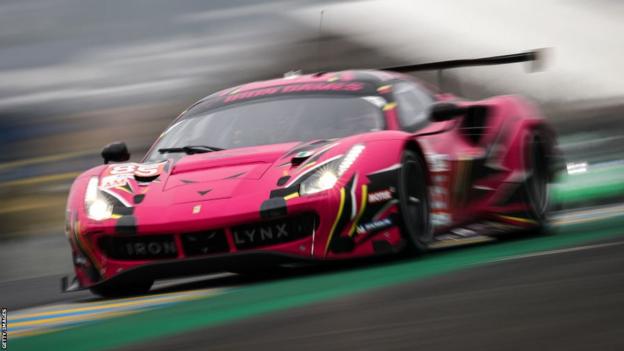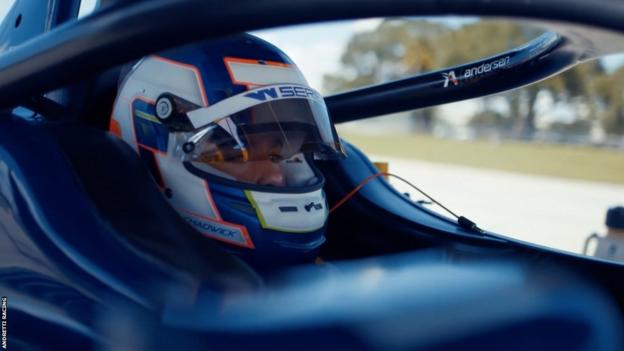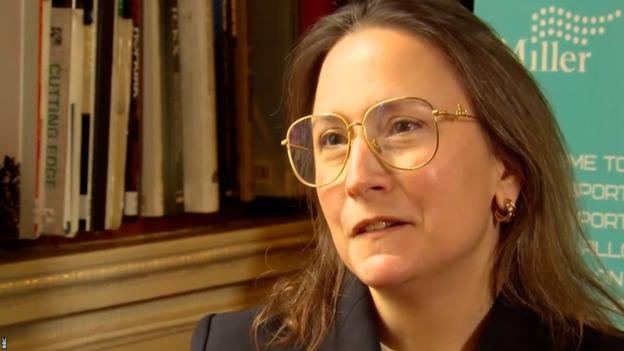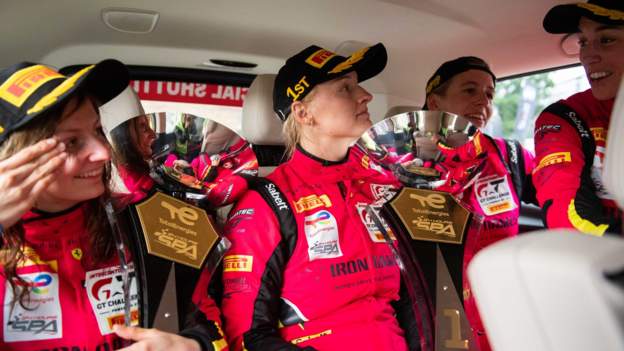Products You May Like
Last updated on .From the section Motorsport
“There were specific moments I really needed to get my knuckles out and do things a female probably wouldn’t normally do. I had to fight to get respect.”
Michelle Gatting is sitting in a hot pre-race briefing room in Portugal before a sports car race in which she will win her class.
The Dane is reflecting on her early days in motorsport, when she didn’t have the recognition she does today, and the reasons why.
And when she says “fight”, she means literally.
“My dad taught me you need to pay them back,” she says, as she recalls an incident with a Swedish driver who kept pushing her off the go-karting track.
“In the end, I had to find this guy. Since then, he realised. But I thought: ‘I cannot keep doing this.’ The talk in the paddock is: ‘She’s crazy, fighting these people.’
“I was probably one of the most feared drivers in the paddock because people were afraid of me, but they didn’t push me off track. This is how I basically gained the respect.”
Gatting, 29, is talking about the sexism she experienced when trying to make her way in motorsport in the late 2000s. She would regularly beat drivers of the calibre of Kevin Magnussen – now in Formula 1 with Haas.
Gatting is competing in a male-dominated sport which appears still not fully compliant with the growing presence of women in the paddock at circuits across the world.
“We had an episode not long ago at a race in Barcelona,” she says. “Fighting [on track] for half an hour. We are not in same category… a driver who would lose nothing by letting me past.
“They see our sister car behind them and let the guys past. As soon as they see my pink car again, they start to defend. It was pure ego.
“In the end, I pass and end up driving away. It hurt his ego. You could hear it screaming out of his helmet.
“But it happens very little. And to see how far we’ve come with the project – walking around the paddock, we are well respected as Iron Dames.”

The challenges facing female drivers
Gatting is part of the all-female Iron Dames team, who have competed in the World Endurance Championship – including the famous Le Mans 24 Hours race – since 2018, making a significant impact on the sport.
The day after our interview, Gatting won the 4 Hours of Portimao in their Ferrari 488 GT – alongside Belgium’s Sarah Bovy and 19-year-old French sensation Doriane Pin.
In a treacherous wet-dry race, Pin took the car from the pits on slick tyres and drove a faultless stint, keeping pace even as rain came and went. The experienced Gatting brought the car home to the delight of the team.
Born out of the Italian Iron Lynx project, the Dames have taken pole positions and class victories as an all-female driver line-up with the support of investment from joint boss Deborah Mayer.
That – along with Britain’s Jamie Chadwick earning a drive in the United States this year after winning the female-only W Series for a third time – means things appear to be looking up for female participation in motorsport.
But there are still no female drivers performing at the very top of the sport, and it is nearly 50 years since Lella Lombardi last contested a Formula 1 grand prix.
Perhaps even more surprising is the fact there are no women in the climate-conscious Formula E, or older more established championships such as the World Rally Championship and the elite class of endurance racing – which race at Le Mans – hypercars.
After setting up the Iron Dames, Mayer herself stepped further into the issue last year, becoming president of the Commission for Women in Motorsport – run by the sport’s world governing body, the FIA.
“I think first thing is to enlarge the base of the pyramid – we need to grow the vocation of younger ones,” Mayer says.
“I’m sure more women will get into the top categories in motorsport, whether hypercar or single-seaters. But to do so we need to create the structure which will allow them to shine and to grow.
“I think the flow will come naturally – what is important is to show women that there are possibilities in motorsport.
“It’s a long-term process. It will take time, but it will come.”

Is there a physical issue?
Mayer was speaking at an event in London intended to increase awareness of female participation in motorsport and motorcycling.
Like horse racing and sailing, motorsport has long been perceived as one of the few sports in which there is a level playing field for men and women to compete.
However, there are questions within motorsport around whether there are physical barriers, as voiced by top management in Formula 1 in recent times.
Chadwick feels it’s something that should be looked at. The 24-year-old is preparing to race in the American Indy NXT series – a feeder category for IndyCars. She will compete against men in faster cars than the W Series, and which – along with Formula 2 – do not have power steering, despite the fact those in F1 do.
“It’s definitely a physical sport, and in F1 a lot of the car is completely adapted to the driver,” she says. “The power-steering consideration – everything revolved around a driver, male or female.
“In a standard spec series, such as F2 or F3, everything else has been designed around the average male driver, and doesn’t have power steering.
“I believe it is possible for women to compete in any championship, however the level of physicality required to get to is very high. So if you’re a 16 or 17-year-old girl developing later than your male counterparts, I don’t understand how you can be expected to be on the same physical level as some of the younger guys.
“With that, there can be considerations made to see if we can make it less physical in F2 or F3 for example. If you’re looking at a pyramid and the highest level is less physical than the steps below then we can see if we can improve that.
“Even the challenge I have in Indy NXT is going to be pretty significant. As a 24-year-old woman later on in my development, I feel confident I can get strong enough, but no way I would have been strong enough three or four years ago.”
Mayer agrees certain things have to be looked at, and she is only one year into a tenure which she sees as a real project of “passion”.
“There are many fields which of course could be adapted or addressed,” she says. “It’s a long-term process.
“When you try to introduce modification and changes, it cannot happen all of a sudden – it’s a step-by-step process.”

The Mayer factor
The FIA is aware of the problem around diversity, thanks in part to seven-time F1 world champion Lewis Hamilton frequently talking about it.
The governing body’s Girls on Track and Rising Stars campaigns are making an impact, with Ferrari taking women from them into its driver development programme.
F1 teams have also introduced female ‘development driver’ roles – but it’s something Gatting sees more as tokenism.
“F1 specifically need to open up about the idea that they can have a female there competing on a good level, because they have tried getting girls in F1 as marketing tools and as a ‘test driver’, but at the end of the day it didn’t do much,” she says. “But it was good for pictures to have a female next to two F1 drivers.”
Chadwick defends the roles, saying hers at Williams has taught her invaluable lessons and given her the required visibility to raise her profile.
F1 as a whole says it is “improving the system” to promote equality, and has a female-only ‘F1 Academy’ starting in the spring. That will involve 15 drivers from five teams competing across 21 rounds, with F1 providing a £2m annual investment in the series.
And Mayer’s appointment at the FIA, aligned with her investment in a team which is breaking down barriers for female participation the sport, is a big one of her “steps”.
She has the power to effect substantial change – not only administratively, but on the ground too: her Iron Lynx project will run a Lamborghini in endurance racing’s elite hypercar class in 2024, across a the World Endurance Championship season – which includes the legendary Le Mans 24 Hours race – just as several of the world’s biggest car manufacturers return to endurance racing.
For Gatting, things have become gradually easier in the sport she loves as the level of respect afforded to her increases.
Things could, however, become historic.
It would be hard for Mayer not to run female drivers who have made such an impact on motorsport in a new top-level car in 2024. Will this be Gatting’s big chance to make her mark?
“I hope so,” she says. “There has been barriers – including sponsors just not being able to get their heads around me driving a car – and they’re still there, but they’re getting smaller. There are females out there who can go all way to F1.
“If you asked four years ago, I would not realise how far we came in such a short amount of time. We want to inspire and try to encourage more young women to get into the sport.
“In the Iron Dames, all of us have been through ups and downs as athletes. It’s not easy getting here.”


